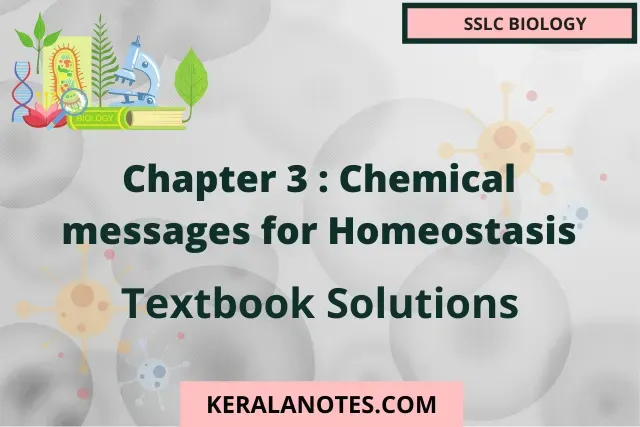Chemical communications for homeostasis solutions in Sensations and Responses-Chapter 3. The Blood, Muscle, and Nerves series, which is discussed in this chapter, discusses the chemical signals that are necessary for body cells to maintain a stable environment. Sensations and Responses revision guides are available below. They were created by our team of knowledgeable and highly experienced instructors, which includes some of Kerala's top scientific educators.
You may speed up your study for the SSLC Biology test by using these review booklets. You may find a brief explanation for each line in the class 10 biology answers pdf by reading the set of Chapter 3 Chemical messages for Homeostasis notes that are provided below. It is perfect for teaching kids about scientific ideas like chemical signals, homeostasis, and reactions in tissues and cell fluids.
This post includes a PDF download link for the textbook solutions to the key problems in SSLC Biology Chapter 3: Chemical Messages for Homeostasis. You can use the materials below as your SSLC curriculum reference guide.
| Board | SCERT, Kerala |
| Text Book | SCERT Based |
| Class | SSLC |
| Subject | Biology Solution |
| Chapter | Chapter 3 |
| Chapter Name | Chemical messages for Homeostasis |
| Category | Kerala SSLC |
Kerala Syllabus SSLC Class 10 Biology Textbook Solution Chapter 3 Chemical messages for Homeostasis
- Chapter 1: Sensations and Responses
- Chapter 2: Windows of Knowledge
- Chapter 3: Chemical messages for Homeostasis
- Chapter 4: Keeping Diseases Away
- Chapter 5: Soldiers of Defense
- Chapter 6: Unravelling Genetic Mysteries
- Chapter 7: Genetics of the Future
- Chapter 8: The Paths Traversed by Life
SSLC Biology Part I
SSLC Biology Part II
Chapter 3 Chemical messages for Homeostasis Textbook Solution
Let us Assess
Qn 1.
Identify the word- pair relationship and fill in the blank.
Thyroxine : Thyroid gland
Epinephrine : …………………..
- Answer)
Adrenal Gland
Qn 2.
Analyse the information given in the box and answer the questions.
X - The production of this hormone is more in night and less in day time. |
| Y - Hormones from the adrenal gland work along with the sympathetic system. |
- Identify and name the hormone 'X' and its gland.
- Identify the hormones indicated as 'Y'
- Answer)
- Melatonin - Pineal Gland
- Epinephrine (Adrenaline) Norepinephrine (Noradrenaline)
Qn 3.
Analyse the illustration and complete the table appropriately.

- Answer)
Endocrine Gland Location Hormones Hypo
thalamus
In the middle of the brain below the thalamus Oxytocin
vasopressin
Pituitary Below the hypothalamus Somatotrophin
tropic hormones
prolactin
Thyroid In the throat just below the larynx Thyroxine
Calcitoxin
Parathyroid Posterior surface of the thyroid Parathormone Thymus just below the sternum Thymosin Pancreas In the abdomen, below the stomach,near to duodenum Insulin
Glucagon
Ovary On the either side of uterus Estrogen
Progesterone
Testis In the scrotum, outside the abdominal cavity. Testosterone Adrenal Above the kidneys Epinephrine (Adrenaline)
Norepinephrine (noradrenaline)
Cortisol
Aldosterone
Pineal In the middle of the brain Melatonin
Qn 4.The hormone that helps in the reabsorption of water in the kidneys.
- TSH
- ACTH
- ADH
- GTH
- Answer)
ADH
Qn 4.
The hormone that helps in the reabsorption of water in the kidneys.
- TSH
- ACTH
- ADH
- GTH
- Answer)
ADH
SSLC Biology Textbook Solution
- Chapter 1: Sensations and Responses
- Chapter 2: Windows of Knowledge
- Chapter 3: Chemical messages for Homeostasis
- Chapter 4: Keeping Diseases Away
- Chapter 5: Soldiers of Defense
- Chapter 6: Unravelling Genetic Mysteries
- Chapter 7: Genetics of the Future
- Chapter 8: The Paths Traversed by Life
SSLC Biology Part I
SSLC Biology Part II
Feel free to comment and share this article if you found it useful. Give your valuable suggestions in the comment session or contact us for any details regarding the HSE Kerala SSLC class 10 syllabus, Previous year question papers, and other study materials.
SSLC Biology Related Links
| SSLC Biology Notes | Click Here |
| SSLC Biology Textbook Solutions | Click Here |
| SSLC Focus Area | Click Here |
| SSLC Previous Year Questions with Solution | Click Here |
| SSLC Latest Syllabus | Click Here |
Other Related Links
| SSLC Physics | Click Here |
| SSLC Chemistry | Click Here |
| SSLC Mathematics | Click Here |
| SSLC Biology | Click Here |
| SSLC Social Science | Click Here |
| SSLC English | Click Here |
We hope the given HSE Kerala Board Syllabus SSLC Biology class 10 Textbook Solutions Chapter Wise Pdf Free Download in both English Medium and Malayalam Medium will help you.
If you have any query regarding the Higher Secondary Kerala SSLC class 10 SCERT syllabus, drop a comment below and we will get back to you at the earliest.






